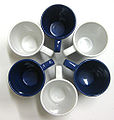Lea-Anne Henry, Andrew J Davies and J Murray Roberts
 Spatial heterogeneity in coral reef communities is well documented. This “species turnover” (beta diversity) on shallow warm-water reefs strongly conforms to spatial gradients in the environment as well as spatially autocorrelated biotic processes such as dispersal and competition. But the extent to which the environment and spatial autocorrelation create beta diversity on deep cold-water coral reefs such as those formed by Lophelia pertusa (Scleractinia) is unknown. The effects of remotely sensed and ground-truthed data were tested on the community composition of sessile suspension-feeding communities from the Mingulay Reef Complex, a landscape of inshore Lophelia reefs off the Scottish west coast. Canonical correspondence analysis determined that a statistically significant proportion (68%) of the variance in community composition could be explained by remotely sensed environmental variables (northerly and easterly aspect, seabed rugosity, depth), ground-truthed environmental variables (species richness and reef macrohabitat) and geospatial location. This variation was further partitioned into fractions explained by pure effects of the environment (51%), spatially structured environmental variables (12%) and spatial autocorrelation (5%). Beta diversity in these communities reflected the effects of both measured and unmeasured and spatially dependent environmental variables that vary across the reef complex, i.e., hydrography. Future work will quantify the significance and relative contributions of these variables in creating beta diversity in these rich communities.
Spatial heterogeneity in coral reef communities is well documented. This “species turnover” (beta diversity) on shallow warm-water reefs strongly conforms to spatial gradients in the environment as well as spatially autocorrelated biotic processes such as dispersal and competition. But the extent to which the environment and spatial autocorrelation create beta diversity on deep cold-water coral reefs such as those formed by Lophelia pertusa (Scleractinia) is unknown. The effects of remotely sensed and ground-truthed data were tested on the community composition of sessile suspension-feeding communities from the Mingulay Reef Complex, a landscape of inshore Lophelia reefs off the Scottish west coast. Canonical correspondence analysis determined that a statistically significant proportion (68%) of the variance in community composition could be explained by remotely sensed environmental variables (northerly and easterly aspect, seabed rugosity, depth), ground-truthed environmental variables (species richness and reef macrohabitat) and geospatial location. This variation was further partitioned into fractions explained by pure effects of the environment (51%), spatially structured environmental variables (12%) and spatial autocorrelation (5%). Beta diversity in these communities reflected the effects of both measured and unmeasured and spatially dependent environmental variables that vary across the reef complex, i.e., hydrography. Future work will quantify the significance and relative contributions of these variables in creating beta diversity in these rich communities.
Published in Coral Reefs 29.
Request PDF
| To request a PDF copy of this paper, please enter your email address below: Your email address is not stored, it is only used to send an email with an attached PDF to you. |
Full citation
Henry L-A, Davies AJ, Roberts JM (2010) “Beta diversity of cold-water coral reef communities off western Scotland” Coral Reefs 29(2): 427-436.
